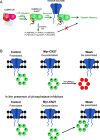CaMKII autophosphorylation is the only enzymatic event required for synaptic memory
- PMID: 38889145
- PMCID: PMC11214084
- DOI: 10.1073/pnas.2402783121
CaMKII autophosphorylation is the only enzymatic event required for synaptic memory
Abstract
Ca2+/calmodulin (CaM)-dependent kinase II (CaMKII) plays a critical role in long-term potentiation (LTP), a well-established model for learning and memory through the enhancement of synaptic transmission. Biochemical studies indicate that CaMKII catalyzes a phosphotransferase (kinase) reaction of both itself (autophosphorylation) and of multiple downstream target proteins. However, whether either type of phosphorylation plays any role in the synaptic enhancing action of CaMKII remains hotly contested. We have designed a series of experiments to define the minimal requirements for the synaptic enhancement by CaMKII. We find that autophosphorylation of T286 and further binding of CaMKII to the GluN2B subunit are required both for initiating LTP and for its maintenance (synaptic memory). Once bound to the NMDA receptor, the synaptic action of CaMKII occurs in the absence of target protein phosphorylation. Thus, autophosphorylation and binding to the GluN2B subunit are the only two requirements for CaMKII in synaptic memory.
Keywords: CaMKII; CaMKII autophosphorylation; LTP; downstream kinase activity; synaptic memory.
Conflict of interest statement
Competing interests statement:The authors declare no competing interest.
Figures






Update of
-
CaMKII autophosphorylation but not downstream kinase activity is required for synaptic memory.bioRxiv [Preprint]. 2023 Aug 26:2023.08.25.554912. doi: 10.1101/2023.08.25.554912. bioRxiv. 2023. Update in: Proc Natl Acad Sci U S A. 2024 Jun 25;121(26):e2402783121. doi: 10.1073/pnas.2402783121. PMID: 37662326 Free PMC article. Updated. Preprint.
Similar articles
-
CaMKII autophosphorylation but not downstream kinase activity is required for synaptic memory.bioRxiv [Preprint]. 2023 Aug 26:2023.08.25.554912. doi: 10.1101/2023.08.25.554912. bioRxiv. 2023. Update in: Proc Natl Acad Sci U S A. 2024 Jun 25;121(26):e2402783121. doi: 10.1073/pnas.2402783121. PMID: 37662326 Free PMC article. Updated. Preprint.
-
DAPK1 Mediates LTD by Making CaMKII/GluN2B Binding LTP Specific.Cell Rep. 2017 Jun 13;19(11):2231-2243. doi: 10.1016/j.celrep.2017.05.068. Cell Rep. 2017. PMID: 28614711 Free PMC article.
-
Individual NMDA receptor GluN2 subunit signaling domains differentially regulate the postnatal maturation of hippocampal excitatory synaptic transmission and plasticity but not dendritic morphology.Synapse. 2024 Jul;78(4):e22292. doi: 10.1002/syn.22292. Synapse. 2024. PMID: 38813758 Free PMC article.
-
The role of CaMKII autophosphorylation for NMDA receptor-dependent synaptic potentiation.Neuropharmacology. 2021 Aug 1;193:108616. doi: 10.1016/j.neuropharm.2021.108616. Epub 2021 May 26. Neuropharmacology. 2021. PMID: 34051268 Review.
-
CaMKII mechanisms that promote pathological LTP impairments.Curr Opin Neurobiol. 2025 Jun;92:102961. doi: 10.1016/j.conb.2024.102961. Epub 2025 Mar 31. Curr Opin Neurobiol. 2025. PMID: 40164520 Review.
Cited by
-
A spatial model of autophosphorylation of Ca2+/calmodulin-dependent protein kinase II (CaMKII) predicts that the lifetime of phospho-CaMKII after induction of synaptic plasticity is greatly prolonged by CaM-trapping.bioRxiv [Preprint]. 2024 Dec 20:2024.02.02.578696. doi: 10.1101/2024.02.02.578696. bioRxiv. 2024. Update in: Front Synaptic Neurosci. 2025 Apr 04;17:1547948. doi: 10.3389/fnsyn.2025.1547948. PMID: 38352446 Free PMC article. Updated. Preprint.
-
AMPA receptor diffusional trapping machinery as an early therapeutic target in neurodegenerative and neuropsychiatric disorders.Transl Neurodegener. 2025 Feb 11;14(1):8. doi: 10.1186/s40035-025-00470-z. Transl Neurodegener. 2025. PMID: 39934896 Free PMC article. Review.
-
Dendritic, delayed, stochastic CaMKII activation in behavioural time scale plasticity.Nature. 2024 Nov;635(8037):151-159. doi: 10.1038/s41586-024-08021-8. Epub 2024 Oct 9. Nature. 2024. PMID: 39385027 Free PMC article.
-
Studying CaMKII: Tools and standards.Cell Rep. 2024 Apr 23;43(4):113982. doi: 10.1016/j.celrep.2024.113982. Epub 2024 Mar 21. Cell Rep. 2024. PMID: 38517893 Free PMC article. Review.
-
A spatial model of autophosphorylation of CaMKII predicts that the lifetime of phospho-CaMKII after induction of synaptic plasticity is greatly prolonged by CaM-trapping.Front Synaptic Neurosci. 2025 Apr 4;17:1547948. doi: 10.3389/fnsyn.2025.1547948. eCollection 2025. Front Synaptic Neurosci. 2025. PMID: 40255983 Free PMC article.
References
-
- Shonesy B. C., Jalan-Sakrikar N., Cavener V. S., Colbran R. J., CaMKII: A molecular substrate for synaptic plasticity and memory. Prog. Mol. Biol. Transl. Sci. 122, 61–87 (2014). - PubMed
MeSH terms
Substances
Grants and funding
LinkOut - more resources
Full Text Sources
Medical
Miscellaneous

